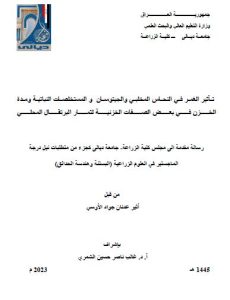Abstract
In this study, α-Fe₂O₃ nanoparticles were synthesized using rosemary leaf extract via green synthesis at pH 3, 7, and 11, and annealed at 650 °C and 750 °C. XRD analysis confirmed the formation of a pure hematite phase with a hexagonal structure in all samples. The crystallite size increased with annealing temperature and decreased with increasing pH, ranging from 54 nm to 126 nm. Higher temperatures led to better crystallinity and reduced lattice strain. FTIR spectra showed strong absorption bands below 600 cm⁻¹, especially near 471 cm⁻¹ and 552 cm⁻¹, confirming Fe–O stretching vibrations characteristic of hematite. FE-SEM analysis revealed that particle morphology and size were affected by pH and temperature. At pH 3, the particles appeared aggregated and polygonal with average sizes of 111.35 nm at 650 °C and 147.37 nm at 750 °C. At pH 7, semi-spherical and moderately dispersed particles were observed with sizes of 67.48 nm at 650 °C and 92.79 nm at 750 °C. For pH 11, the particles were more uniform and smaller, measuring 59.64 nm at 650 °C and 69.78 nm at 750 °C. Magnetic measurements (VSM) demonstrated weak ferromagnetic behavior in all samples. The coercivity (Hc) increased with temperature, reaching 2868 Oe at pH 3 and 750 °C, indicating enhanced magnetic anisotropy. Saturation magnetization (Ms) varied with size and morphology, peaking at lower pH values. Zeta potential analysis revealed positive values at 650 °C (+11.1 mV at pH 11) and negative values at 750 °C (−12.3 mV at pH 11), suggesting improved colloidal stability with higher pH and annealing temperature. Dielectric properties showed typical dispersion behavior. The dielectric constant (ε’) decreased with frequency and increased with particle size. Maximum ε’ was observed in samples with larger crystallite size at 750 °C, while dielectric loss (ε”) decreased at higher frequencies due to reduced polarization. AC conductivity increased with frequency, confirming hopping conduction. Antibacterial activity was significant against Pseudomonas aeruginosa and Staphylococcus aureus. The highest inhibition zones were recorded at pH 11 and 650 °C with 250 µg/ml concentration: 32 mm for P. aeruginosa and 28 mm for S. aureus, indicating strong antibacterial efficiency dependent on pH and concentration.





